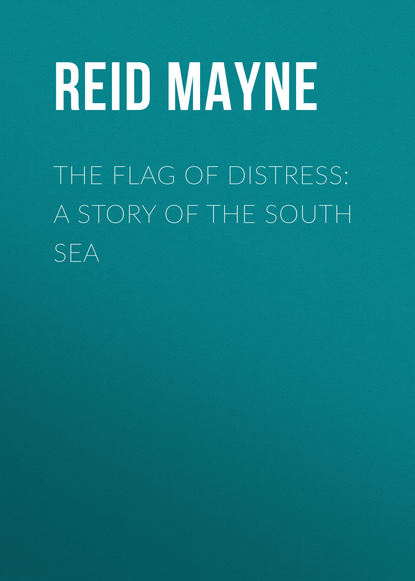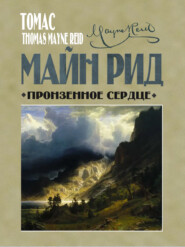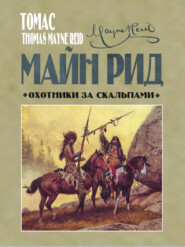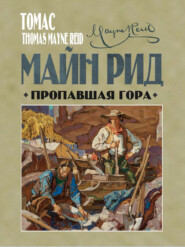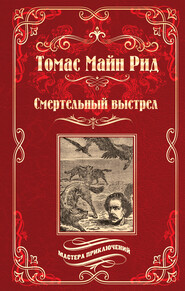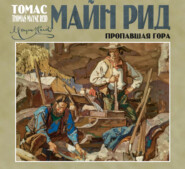По всем вопросам обращайтесь на: info@litportal.ru
(©) 2003-2024.
✖
The Flag of Distress: A Story of the South Sea
Настройки чтения
Размер шрифта
Высота строк
Поля
Don Gregorio Montijo is a Spaniard, who, some ten years previous to the time of which we write, found his way into the Republic of Mexico, afterwards moving on to “Alta California.” Settling by San Francisco Bay, he became a ganadero, or stock-farmer – the industry in those days chiefly followed by Californians.
His grazing estate gives proof that he has prospered. Its territory extends several miles along the water, and several leagues backward; its boundary in that direction being the shore of the South Sea itself; while a thousand head of horses, and ten times the number of horned cattle, roam over its rich pastures.
His house stands upon the summit of a hill that rises above the bay – a sort of spur projected from higher ground behind, and trending at right angles to the beach, where it declines into a low-lying sand-spit. Across this runs the shore-road, southward from the city to San José, cutting the ridge midway between the walls of the house and the water’s edge, at some three hundred yards distance from each.
The dwelling, a massive quadrangular structure – in that Span-Moriscan style of architecture imported into New Spain by the Conquistadores– is but a single storey in height, having a flat, terraced roof, and inner court: this last approached through a grand gate entrance, centrally set in the front façade, with a double-winged door wide enough to admit the coach of Sir Charles Grandison.
Around a Californian country-house there’s rarely much in the way of ornamental grounds – even though it be a hacienda of the first-class. And when the headquarters of a grazing estate, still less; its inclosures consisting chiefly of “corrals” for the penning and branding of cattle, these usually erected in the rear of the dwelling. To this almost universal nakedness the grounds of Don Gregorio offer some exception. He has added a stone fence, which, separating them from the high road, is penetrated by a portalled entrance, with an avenue that leads straight up to the house. This, strewn with snow-white sea-shells, is flanked on each side by a row of manzanita bushes – a beautiful indigenous evergreen. Here and there a clump of California bays, and some scattered peach-trees, betray an attempt, however slight, at landscape gardening.
Taking into account the grandeur of his house, and the broad acres attached to it, one may safely say, that in the New World Don Gregorio has done well. And, in truth, so has he – thriven to fulness. But he came not empty from the Old, having brought with him sufficient cash to purchase a large tract of land, as also sufficient of horses and horned cattle to stock it. No needy adventurer he, but a gentleman by birth; one of Biscay’s bluest blood – hidalgos since the days of the Cid.
In addition to his ready-money, he also brought with him a wife – Biscayan as himself – and a daughter, at the time turned eight years old. His wife has been long ago buried; a tombstone in the cemetery of the old Dolores Mission commemorating her many virtues. Since, he has had an accession to his contracted family circle; the added member being a grand-daughter, only a year younger than his daughter, but equally well grown – both having reached the ripest age of girlhood. It is scarce necessary to add, that the young ladies, thus standing in the relationship of aunt and niece, are the two with whom Edward Crozier and Willie Cadwallader have respectively fallen in love.
And while mate and midshipman are on the way to pay them a promised visit – for such it is – a word may be said about their personal appearance. Though so closely allied, and nearly of an age, in other respects the two differ so widely, that one unacquainted with the fact would not suspect the slightest kinship between them.
The aunt, Doña Carmen, is of pure Biscayan blood, both by her father’s and mother’s side. From this she derives her blonde complexion, with that colour of hair so admired by Mr Crozier; with the blue-grey eyes, known as “Irish” – the Basques and Celts being a kindred race. Her Biscayan origin has endowed her with a fine figure of full development, withal in perfect feminine proportions; while her mother has transmitted to her what, in an eminent degree, she herself possessed – beauty of face and nobleness of feature.
In the daughter neither has deteriorated, but perhaps improved. For the benignant clime of California has such effect; the soft breezes of the South Sea fanning as fair cheeks as were ever kissed by Tuscan, or Levantine wind.
A chapter might be devoted to the charms of Doña Carmen Montijo, and still not do them justice. Enough to say, that they are beyond cavil. There are men in San Francisco who would dare death for her sake, if sure of her smile to speak approval of the deed; ay, one who would for as much do murder!
And in that same city is a man who would do the same for Iñez Alvarez – though she has neither blonde complexion, nor blue eyes. Instead she is a morena, or brunette, with eyes and hair of the darkest. But she is also a beauty, of the type immortalised by many bards – Byron among the number, when he wrote his rhapsody on the “Girl of Cadiz.”
Iñez is herself a girl of Cadiz, of which city her father was a native. The Conde Alvarez, an officer in the Spanish army, serving with his regiment in Biscay, there saw a face that charmed him. It belonged to the daughter of Don Gregorio Montijo – his eldest and first-born, some eighteen years older than Carmen. The Andalusian count wooed the Biscayan lady, won, and bore her away to his home. Both have gone to their long home, leaving their only child inheritress of a handsome estate. From her father, in whose veins ran Moorish blood, Iñez inherits jet-black eyes, with lashes nearly half-an-inch in length, and above them brows shaped like the moon in the middle of her first quarter. Though in figure more slender than her aunt, she is quite Carmen’s equal in height, and in this may some day excel; since she has not yet attained her full stature.
Such are the two damsels, who have danced with the young British officers, and made sweet havoc in their hearts. Have the hearts of the señoritas received similar hurt in return? By listening to their conversation we shall learn.
Chapter Eleven.
Mutual Admissions
The dwelling of Don Gregorio Montijo, as already stated, is terrace-topped, that style of roof in Spanish countries termed azotea. This, surrounded by a parapet breast-high – beset with plants and flowering shrubs in boxes and pots, thus forming a sort of aerial garden – is reached by a stone stair, the escalera, which leads up out of the inner court, called patio. During certain hours of the day, the azotea is a favourite resort, being a pleasant place of dalliance, as also the finest for observation – commanding, as in this case it does, a view of the country at back, and the broad bay in front. To look upon this last have the two “señoritas,” on the same morning, ascended – soon after breakfast, which in all parts of Spanish America is eaten at the somewhat late hour of 11 a.m.
That they do not intend staying here long, is evident from the character of their dresses. Both are costumed and equipped for the saddle; having hats of vicuña wool on their heads, riding-whips in their hands, and spurs on their heels; while in the courtyard below stand four horses, saddled and bridled, champing their bits, and impatiently pawing the flagged pavement.
Since all the saddles are such as are usually ridden by men, it may be supposed only men are to be mounted, and that the ladies’ horses have not yet been brought out of the stable. This would naturally be the conjecture of a stranger to Spanish California. But one an fait to its fashions would draw deductions differently. Looking at the spurred heels upon the house-top, and the saddled horses below, he would conclude that two of the steeds were intended to be ridden by the ladies; in that style of equitation with which the famed Duchesse de Berri was accustomed to astonish the Parisians.
The other two horses, having larger and somewhat coarser saddles, are evidently designed for gentlemen; so that the cavalcade will be symmetrically composed – two and two of each sex.
The gentlemen have not yet put in an appearance; but who they are may be learnt from the dialogue passing between the two ladies. From their elevated, position they can see the rapidly growing city of San Francisco, and the shipping in its harbour – north-east, and a little to their left. But there are several vessels riding at anchor out in front of them; one a warship, towards which the eyes of both keep continuously turning, as though they expected a boat soon to put off from her side.
As yet none such has been seen; and, withdrawing her gaze from the warship, Iñez opens the conversation by a question —
“Is it really true that we’re going back to Spain?”
She has been in California only a short time, since the death of her father and mother, which placed her under the guardianship of Don Gregorio. But though here, lovers have been all the while sighing around her, she longs to return to her dear Andalusia. Therefore has she asked the question with more than a common interest.
“Quite true;” says Carmen, giving the answer, “and I’m sorry it is so.”
“Why should you be sorry?”
“There are many reasons.”
“Give one.”
“I could give twenty.”
“One will be sufficient – if good.”
“They’re all good.”
“Let me hear them, then.”
“First of all, I like California – I love it. Its fine climate, and bright blue sides.”
“Not a bit brighter, or bluer, than those of Spain.”
“Ten times brighter, and ten times bluer. The skies of the Old-World are to those of the New as lead to lapis lazuli. In that respect, neither Spain nor Italy can compare with California. Its seas, too, are superior. Even the boasted Bay of Naples would be but a poor pond alongside that noble sheet of water, far-stretching before our eyes. Look at it!”
“Looking at it through your eyes, I might think so; not through mine. For my part, I see nothing in it to be so much admired.”
“But something on it; for instance, that grand ship out yonder. Come, now; confess the truth! Isn’t that something to admire?”
“But she don’t belong to your bay,” replies the Andalusian.
“No matter. There is on it now, and in it – the ship I mean – somebody who, if I mistake not, has very much interested somebody else – a certain Andalusian lady, by name Iñez Alvarez.”
“Your words will answer as well for a Biscayan lady – by name Carmen Montijo.”
“Suppose I admit it, and say yes? Well; I will. There is one in yonder ship who has very much interested me. Nay, more; I admire – ay, love him! You see I’m not ashamed to confess what the world affects to consider a weakness. We of the Celtic race don’t keep secrets as you of the further South; half Moors, as you are. For all, sobrina, you haven’t kept yours; though you tried heard enough. I saw from the first you were smitten with that young English officer, who has hair the exact colour of a carrot!”
“It isn’t anything of the kind. His hair is of a much more becoming hue than that of the other English officer, who’s taken your fancy, tia.”
“Nothing to compare with it. Look at this. There’s a curl; one of the handsomest that ever grew on the head of man! Dark and glossy, as the coat of the fur-seal. Beautiful! I could kiss it over, and over again!”
While speaking, she does so.
“And look at this!” cries the other, also drawing forth a lock of hair, and displaying it in the sunlight, “See how it shines – like tissue of gold! Far prettier than that you’ve got, and better worth kissing.”
Saying which she imitates the example set her, by raising the tress to her lips, and repeatedly kissing it.
“So, so, my innocent!” exclaims Carmen, “you’ve been stealing too?”
“As yourself!”
“And, I suppose, you’ve given him a love-lock in exchange?”
“Have you?”





